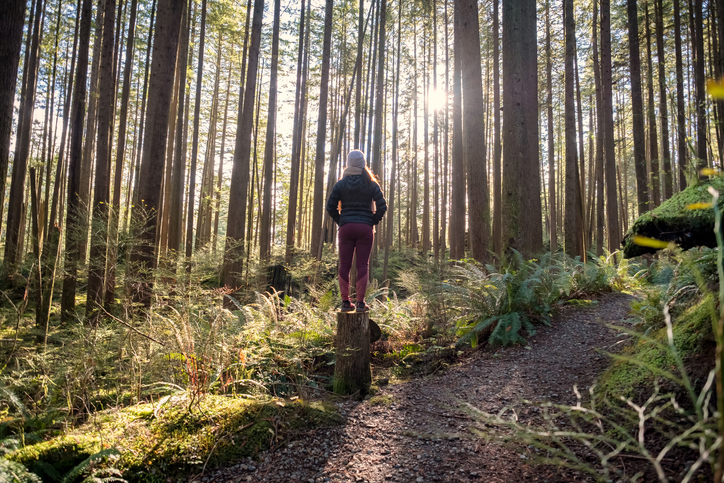What Is Forest Bathing and How Does it Benefit Mental and Physical Health?
“In every walk with Nature one receives far more than he seeks.” ― John Muir*
For many people, a walk in the forest has long been a relaxing and rejuvenating escape from daily stresses. There is growing medical evidence that immersing oneself in a forest environment can have significant physical and mental health benefits.
According to the Global Wellness Institute, forest therapy (or forest bathing) broadly means taking in, through all of one’s senses, the forest atmosphere. It is not simply a walk in the woods, but a conscious and contemplative practice of being immersed in the sights, sounds and smells of the forest. It is focused on slowing down and appreciating all aspects of the environment. Forest therapy originated with the Japanese practice of shinrin-yoku, which translates to “forest bathing,” developed in the 1980s to promote physical and mental health.

According to proponents, forest bathing can be therapeutic, countering some of the negative effects of our technology-driven, climate-controlled, fast-paced, often highly stressed daily lives. Researchers have established a growing body of scientific literature on the diverse health benefits, including improving health and well-being at the physiological, emotional, cognitive, social and spiritual levels.
The physical and mental health benefits from exposure to forests and other natural environments include positive effects on cardiovascular and immune systems and reduced stress levels. A study by researchers in Japan found that for a group of urban office workers, the physiological and psychological relaxation benefits lasted three to five days after forest therapy. One study found that compared to an urban walk, a leisurely forest walk led to 12 percent lower stress hormone levels, as well as decreased blood pressure and heart rate and boosted immune function. Studies have also found that walking in nature improves attention and reduces ADHD symptoms in children, and it has also been associated with increased creativity and problem-solving ability.
Several studies have associated nature walks with improvements in mood. A study from researchers at the University of Michigan looked at the effects of a walk in the woods on people with depression. The researchers concluded that interacting with nature may be useful clinically as a supplement to existing treatments for major depression. Forest therapy has also shown the potential to help in recovery from trauma and PTSD.
Getting Started
University of Wisconsin-La Crosse Assistant Professor Namyun Kil, Ph.D., a certified forest therapy guide, explains that forest bathing involves slow, mindful sensory connection activities that “typically occur for about two hours within a mile or less of walking, but it can occur in as little as 10-15 minutes or longer term such as days or weeks.“ And it is not limited to just forests — a park, yard, botanical garden or other natural area also works. Professor Kil offers some tips for getting started
- Silence your phone.
- Respect nature.
- Walk slowly and mindfully.
- Focus on your multiple senses — one at a time.
- Find a safe and comfortable spot that draws your attention.
- Invite a sense of solitude.
- Listen to your heart in the present moment.
- Take time for self-reflection or group reflection on your overall journey through the forest or nature.
In addition, Kil notes, forest bathing can be done in any season, with changing seasons offering different sights and experiences.
You can also experience a more structured forest bathing experience. National Geographic recently reported on certified forest therapy trails around the world and five places where you can join trained guides for a meditative two- to three-hour ecotherapy excursion.
A recent study compared guided forest therapy versus experiencing forest bathing alone. It found that self-guided forest therapy provided “an opportunity for self-reflection to focus on and think about one’s inner self,” while the guided forest therapy programs provided “positive emotional changes and promoting social bonds through interaction with others.” Both forms of forest therapy provided numerous health benefits, including change of mind and body, introspection, change of emotion, cognitive change, and social interaction.
Forest therapy may be just the needed antidote to too much screen time and stress in our everyday lives. With very little cost, effort, or side effects, this practice, or at least a regular leisurely, contemplative walk in the woods, may be worth a try.
More information
*John Muir (1838 – 1914) was a Scottish-American naturalist, author, and early advocate of preservation of wilderness in the United States. His activism helped to preserve the Yosemite Valley, Sequoia National Park and other wilderness areas. He was co-founder of the Sierra Club.
References
- Kim, J. G., & Shin, W. S. (2021). Forest Therapy Alone or with a Guide: Is There a Difference between Self-Guided Forest Therapy and Guided Forest Therapy Programs? International journal of environmental research and public health, 18(13), 6957. https://doi.org/10.3390/ijerph18136957
- Kil, N. 2022. What is forest bathing? Currents, University of Wisconsin – La Crosse.
- Berman, MG, et al. Interacting with Nature Improves Cognition and Affect for Individuals with Depression. J Affect Disord. 2012 Nov; 140(3): 300–305.
- Hansen, M. M., Jones, R., & Tocchini, K. (2017). Shinrin-Yoku (Forest Bathing) and Nature Therapy: A State-of-the-Art Review. International journal of environmental research and public health, 14(8), 851. https://doi.org/10.3390/ijerph14080851
